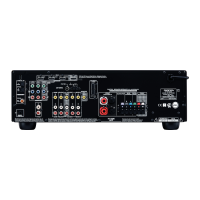22
En
You can store a combination of up to 40 of your favorite
FM/AM radio stations as presets.
Selecting Presets
Tip
• You can also use the remote controller’s number buttons to select
a preset directly.
Deleting Presets
When tuned into an RDS station, the RDS indicator lights.
What is RDS?
RDS stands for Radio Data System and is a method of
transmitting data in FM radio signals. It was developed by
the European Broadcasting Union (EBU) and is available
in most European countries. Many FM stations use it these
days. In addition to displaying text information, RDS can
also help you find radio stations by type (e.g., news, sport,
rock, etc.).
The AV receiver supports four types of RDS information:
■ PS (Program Service)
When tuned to an RDS station that’s broadcasting PS
information, the station’s name will be displayed. Press-
ing DISPLAY will display the frequency for 3 seconds.
■ RT (Radio Text)
When tuned to an RDS station that’s broadcasting text
information, the text will be shown on the display as
described in the next section.
■ PTY (Program Type)
This allows you to search for RDS radio stations by type
(➔ 23).
■ TP (Traffic Program)
This allows you to search for RDS radio stations that
broadcast traffic information (➔ 23).
Note
• In some cases, the text characters displayed on the AV receiver
may not be identical to those broadcast by the radio station. Also,
unexpected characters may be displayed when unsupported
characters are received. This is not a malfunction.
• If the signal from an RDS station is weak, RDS data may be
displayed intermittently or not at all.
When tuned to an RDS station that’s broadcasting text
information, the text can be displayed.
Displaying Radio Text (RT)
Note
• The message “Waiting” may appear while the AV receiver waits
for the RT information.
• If the message “No Text Data” appears on the display, no RT
information is available.
Presetting FM/AM Stations
1
Tune into the FM/AM station that you want to
store as a preset.
See the previous section.
2
Press MEMORY.
The preset number flashes.
3
While the preset number is flashing (about 8 sec-
onds), use PRESET e/r to select a preset from 1
through 40.
4
Press MEMORY again to store the station or chan-
nel.
The station or channel is stored and the preset num-
ber stops flashing.
Repeat this procedure for all of your favorite FM/
AM radio stations.
To select a preset, use PRESET e/r on the AV
receiver, or the remote controller’s CH +/–.
1
Select the preset that you want to delete.
See the previous section.
2
While holding down MEMORY, press TUNING
MODE.
The preset is deleted and its number disappears from
the display.
Using RDS
RDS works only in areas where RDS broadcasts are
available.
Press RT/PTY/TP once.
The RT information scrolls across the display.

